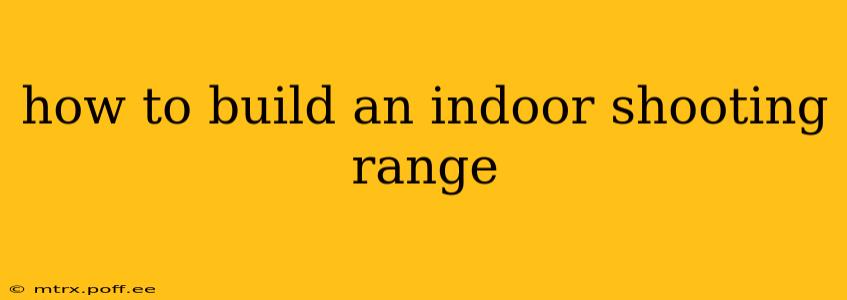How to Build an Indoor Shooting Range: A Comprehensive Guide
Building an indoor shooting range is a significant undertaking, requiring careful planning, substantial investment, and adherence to strict safety regulations. This guide outlines the key steps and considerations for creating a safe and effective indoor shooting facility. Whether you're a serious enthusiast or a business owner, understanding these aspects is crucial.
1. Planning and Legal Considerations:
Before you even think about laying down concrete, thorough planning is paramount. This includes:
- Local Zoning and Permits: This is arguably the most important step. Contact your local authorities to determine zoning regulations, building codes, and the permitting process for constructing an indoor shooting range. Requirements vary drastically depending on location, so early consultation is vital to avoid costly delays or outright prohibition. Specific permits may be required for firearm storage, ammunition sales, and the use of certain calibers.
- Noise Ordinances: Indoor shooting ranges generate significant noise. Assess local noise ordinances and consider noise mitigation strategies early on, such as soundproofing materials and baffles.
- Environmental Impact Assessment: Depending on your location, an environmental impact assessment might be required to evaluate potential impacts on air and water quality, and waste disposal from lead-containing materials.
- Insurance: Securing adequate liability insurance is crucial to protect yourself and your business from potential accidents and lawsuits. The cost and coverage of your insurance will depend heavily on the size and scope of your range.
- Safety Regulations: Research and comply with all relevant safety regulations for firearm handling, range operation, and waste disposal (specifically lead). These regulations can be stringent, so ensure you're familiar with them from the beginning.
2. Designing Your Indoor Shooting Range:
Careful design is key to a safe and efficient range. Consider the following:
- Size and Layout: The size will dictate the number of shooting lanes and the types of firearms that can be safely accommodated. Allow for ample space between shooting lanes for safety. Consider the flow of traffic, including entry and exit points, and the positioning of safety equipment.
- Shooting Lanes: The number of lanes depends on your intended use. Each lane needs a proper backstop, lighting, and target holders. The length of the lanes should accommodate various firearms and shooting disciplines.
- Backstops: The backstop is arguably the most critical safety feature. It needs to be designed to safely stop all projectiles fired within the range. Consider using specialized backstop materials designed for bullet impact and lead containment.
- Ventilation: Proper ventilation is essential to remove lead dust and spent gases generated by firearms. A high-volume, low-speed ventilation system is generally recommended. The system should ensure proper air exchange and prevent the build-up of harmful contaminants.
- Lighting: Adequate lighting is crucial for safety and visibility. Ensure the lighting is bright enough to allow for clear target acquisition but avoids glare.
- Soundproofing: Effective soundproofing is crucial to mitigate noise pollution. This might involve using sound-absorbing materials such as acoustic panels on walls, ceilings, and floors.
3. Construction and Materials:
Construction involves several key aspects:
- Foundation: A strong foundation is essential to support the weight of the backstop and other structures.
- Walls and Floors: Durable and lead-resistant materials are needed for the walls and floors. Consider using concrete, specialized ballistic-resistant panels, or a combination of materials.
- Backstop Construction: The backstop must be designed to absorb projectile impact without causing ricochets or allowing bullets to penetrate. Consult with specialists in ballistic protection for design and material recommendations.
- Ventilation System Installation: Proper installation of the ventilation system is critical to ensuring efficient air exchange and the removal of harmful contaminants.
- Electrical and Lighting Installation: Ensure compliance with all electrical codes and regulations.
4. Equipment and Safety Features:
Essential equipment includes:
- Firearm Storage: Secure firearm storage is mandatory. Consider using safes or racks compliant with local regulations.
- Hearing Protection: Provide adequate hearing protection for all shooters.
- Eye Protection: Eye protection is also vital.
- Emergency Response Plan: Develop and implement a comprehensive emergency response plan to address potential accidents or injuries.
- First-Aid Kit: Keep a well-stocked first-aid kit on site.
How Much Does it Cost to Build an Indoor Shooting Range?
The cost varies significantly depending on size, location, features, and materials. Expect a substantial investment, ranging from tens of thousands to hundreds of thousands of dollars, or even more for larger, more sophisticated facilities. Detailed cost estimates should be obtained from contractors and specialized range-building companies.
What Permits Do I Need to Open an Indoor Shooting Range?
Permits vary by location. You'll likely need building permits, business licenses, and possibly special permits related to firearm handling, ammunition sales, and waste disposal. Consult with your local authorities early in the process.
Are Indoor Shooting Ranges Profitable?
Profitability depends on several factors, including location, target market, pricing strategy, operating costs, and competition. Thorough market research and a well-developed business plan are crucial for success.
This comprehensive guide provides a starting point. Remember, this is a complex undertaking requiring professional advice from architects, contractors, and safety experts specializing in range construction. Always prioritize safety and compliance with all relevant regulations.
